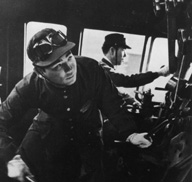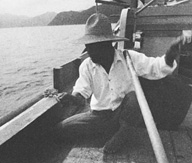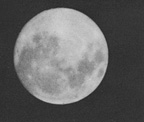An Engineer’s Assistant
(“Aru kikan joshi”) JAPAN / 1963 / Japanese / Color / 35mm / 37 min / Subtitled in English
JAPAN / 1963 / Japanese / Color / 35mm / 37 min / Subtitled in English
Director, Script: Tsuchimoto Noriaki
Photography: Negishi Sakae
Sound: Yasuda Tetsuo
Music: Miki Minoru
Producer: Oguchi Teizo
Production Company: Iwanami Productions
Source: The Japan Foundation
In 1962, the service schedule of the National Railways became increasingly congested due to transport of materials and Shinkansen deployment in preparation for the Olympics, and intensified labor schedules were imposed. On May 2 of that year a major accident occurred at Mikawashima. In order to wipe away the bad impression of the accident, the JNR authorities planned a film to promote the safety of the railways. The film traces a day in the life of an engineer’s assistant.
Fishing Moon
(“Umi to otsukisama tachi”) JAPAN / 1980 / Japanese / Color / 16mm (Original: 35mm) / 50 min
JAPAN / 1980 / Japanese / Color / 16mm (Original: 35mm) / 50 min
Director: Tsuchimoto Noriaki
Photography: Segawa Junichi
Sound: Akasaka Shuichi
Music: Matsumura Teizo
Producer: Mogi Masatoshi
Production Company: Document Film Production Institute of Japan
Source: Cine Associé
Since Minamata: The Victims and Their World (1971), director Tsuchimoto Noriaki has made numerous works depicting people living in Minamata. This work for children is a visual fantasy poetically depicting the moon that governs the ocean’s tides, the fishermen who read the tidal currents, and the various fish living in the Shiranui Sea.
[Director’s Statement] In my filmography, An Engineer’s Assistant (1963) is called my “first film.” This PR film on the safety of the Japanese National Railways was designed to be “self-criticism” after the big accident on the Joban line at Mikawashima Station, which had occurred in 1962. Right after the events back then, the responsibility for the accident was considered to be negligence of the engineer and the engineer’s assistant. The topic of this project was the promotion of a new device to avoid accidents. However, I had seen that the true cause of the accident was a congested service schedule, and I consciously placed emphasis on the depiction of the actual work of the engineer and his assistant, and of those who had chosen the route and were responsible for safety on the line on which the accident took place. Seventeen film companies made bids at the time to produce this film. I had never imagined they would enter the bidding for this kind of story focusing on the crew members of the ill-reputed route. As director I went over to the JNR Labor Union, which had officially taken the blame, and I earned their understanding and cooperation for a story analytically depicting their work. That this scenario could be made into a film was because both labor and management held some lingering attachment to the “vanishing era of the locomotive engine.” The company spent an enormous amount of funds to make this film on the work of its crew members. That in itself made it an exceptional film, so it was said. It stems from a time when PR films were said to be the only choice.
 Fishing Moon (1980) is a documentary made for children. During the making of it I realized that children possess the power to rapidly grasp images, and have the sensibility to understand even jump cuts. On that point, I learned that silent film-like editing and film-poetic scenes are more likely to draw approval and admiration from innocent children. This is that kind of image-oriented work . . . It remains a work in which the images of aesthetic-minded cameraman Segawa Junichi and Ichinose Masashi, with his flair for physical description, are brought to life on 35mm film. The setting for this film is the Shiranui Sea, the same inland body of water as of the Minamata incident. The fish that come in from the open sea to lay eggs, the various living creatures inhabiting the shallow waters . . . The battle of wits with octopus, squid, blowfish, and bream brings meaning and joy to the fishermen’s life, an interaction with living creatures concentrated in the fingertips and fishing lines. The moon changes daily—full moon, half moon, crescent moon—and in the world of the fishing folk, the moon is pictured as one more “sun.” (This film is appreciated most of all by the fishermen sick with Minamata Disease, because, they say, “it portrays the sea of Minamata before the eruption of the illness.”)
Fishing Moon (1980) is a documentary made for children. During the making of it I realized that children possess the power to rapidly grasp images, and have the sensibility to understand even jump cuts. On that point, I learned that silent film-like editing and film-poetic scenes are more likely to draw approval and admiration from innocent children. This is that kind of image-oriented work . . . It remains a work in which the images of aesthetic-minded cameraman Segawa Junichi and Ichinose Masashi, with his flair for physical description, are brought to life on 35mm film. The setting for this film is the Shiranui Sea, the same inland body of water as of the Minamata incident. The fish that come in from the open sea to lay eggs, the various living creatures inhabiting the shallow waters . . . The battle of wits with octopus, squid, blowfish, and bream brings meaning and joy to the fishermen’s life, an interaction with living creatures concentrated in the fingertips and fishing lines. The moon changes daily—full moon, half moon, crescent moon—and in the world of the fishing folk, the moon is pictured as one more “sun.” (This film is appreciated most of all by the fishermen sick with Minamata Disease, because, they say, “it portrays the sea of Minamata before the eruption of the illness.”)
 Tsuchimoto Noriaki
Tsuchimoto Noriaki
Born in 1928 in Toki City, Gifu Prefecture, Tsuchimoto began his work in film in 1956 contracted to Iwanami Productions. His directorial debut was An Engineer’s Assistant (1963), a Japan National Railways PR film. After that he became independent and made Document: On the Road (1964), The World of the Siberians (1968), and Pre-Partisan (1969). From the seventies he made films on Minamata, such as Minamata: The Victims and Their World (1971), of which the latest, Minamata Diary: Visiting Resurrected Souls (2004), marks his sixteenth Minamata film. Not content only with making the films, in 1975 he took his Minamata work on a 100-day screening tour across Canada. In 1977 he held 76 screenings at 65 locations over 100 days, on his “Shiranui Sea: A Film Crew Across the Sea” tour. His other works include A Scrapbook about Nuclear Power Plants (1982), which depicts the issue of nuclear power using only newspaper articles, and Okhotsk Sea in Crisis (1994), for which he reported on the four islands of the Northern Territories together with Otsu Koshiro. In 1989 he went to Afghanistan and made Afghan Spring. At present he is planning new films with his company Eiga Dojin Cine Associé. His writings include Film Is the Job of Living Creatures and Records in Misfortune (both Miraisha). |
